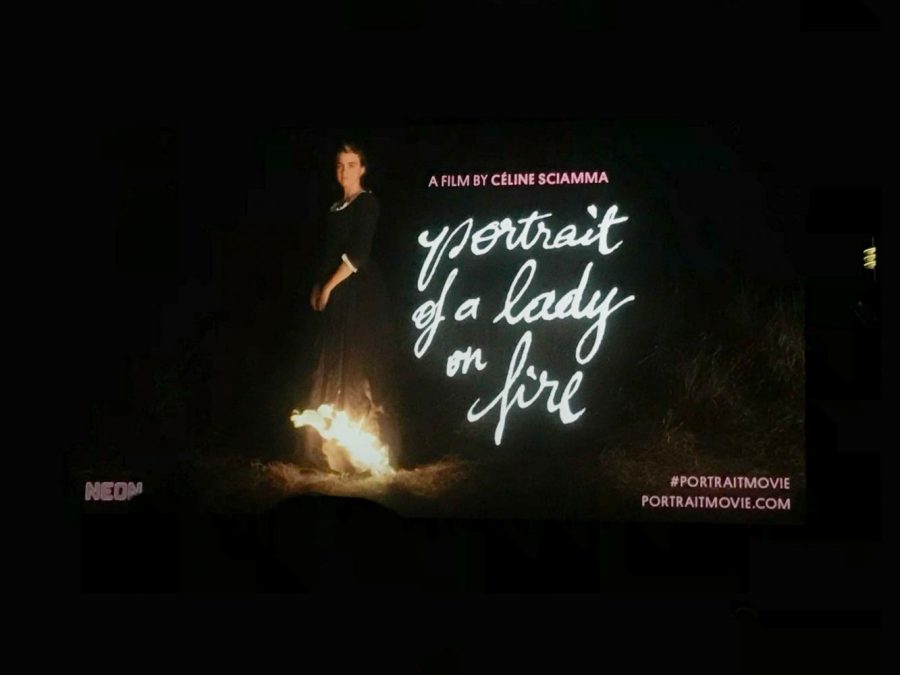The Cannes Film Festival Award for Best Screenplay Winner is a stunning portrayal of love through the gaze of an artist.
A group of women hum different notes around a fire. As they get closer, they begin to hum in harmony, chanting “fugere non possum,” Latin for “we cannot escape.” In the darkness, a female face is illuminated as she gazes at a blonde woman across the fire. Subtle desire fills both of them. As the music reaches a crescendo, the blonde steps away to reveal the bottom of her dress is on fire. The two continue their staring match as the blonde stands completely still, an exquisite image, a living painting.
“Portrait of a Lady on Fire” follows Marianne (Noémie Merlant) as she is commissioned to paint a portrait of Héloïse (Adèle Haenel) to be sent to her future arranged husband. Héloïse refuses to sit for the painting, so Marianne must work secretly, creating a face from only glances on daily walks. From this, the two fall into an impassioned, affecting romance that allows them to find their inner freedom while also highlighting the limitations of the world they live in.
“Portrait of a Lady on Fire” is one of the most magnificent love stories to be put to film in recent memory. The film looks at the way love can be defined in how one is seen in the eyes of another, more specifically, without the male gaze present. When Héloïse insults the first portrait, she says, “Is this how you see me?” and it is the inquiry that seems to bother Marianne the most. The film argues that having the person you desire find your perception of them false is the worst insult. It argues that real love means being fully seen by another and not as just a still life but as a living breathing entity.
This movie is not just about love between women; it also delves into the intense bond that women share. This bond is highlighted through a third character, a maid named Sophie (Luàna Bajrami), whom both women help throughout the film. The power of the film is in this shared connection that all the women have as they all face different circumstances that they wish they could escape from.
Céline Sciamma’s screenplay is so intricate and lush in its phrasing that one would think it came from a classic 18th-century romance novel. The poetry of the lines is something that creeps up on the audience and does not always make itself known. One such series of lines appear, in a conversation the three women share over a book they are reading aloud about Orpheus and Eurydice.
“He doesn’t make the lover’s choice, but the poet’s,” is what Marienne says when talking of why she thinks Orpheus turns and thus sends his lover, Eurydice, back to the Underworld. It is to live with the memory of how Eurydice was instead of who she is now. What initially started as an exciting sharing of theories turns into a poignant exchange that reveals the women’s personal understandings of love and the impending separation from each other.
All performances in this film are nuanced, and it is hard to single out just one of them as the star. The fire and intense life each woman brings to their role makes it feel like these characters are existing individuals. They bring such energy to them that one never feels that these people were just dropped into the film and instead had an extensive life before, during and after the film has faded to black. Adèle Haenel is so restrained in her emotions, but in every scene, one can feel the desire that lies behind the wall she has put up. Noémie Merlant is dominant in the independence she portrays, but also the impending awareness of her circumstance as a woman. Both women are brilliant, and it is a spiritual experience to watch the two fall fast into love.
The cinematography of the film works in tandem with the narrative. Each shot in the movie could be a painting within itself as the landscapes are breathtakingly gorgeous, and the staging of the scenes is so intentional in the visual they are trying to achieve. The staging isn’t done with just visuals in mind either; many scenes are placed so that one can tell what is happening emotionally between characters or to draw the audience in. While the acting, direction and screenplay are all stunning in their own right, it is the cinematography that helps round out this film and make it a true masterpiece.
“Portrait of a Lady on Fire” exudes beauty in every second of the film. It draws the audience in with the visuals but holds onto them with the passionate prose that makes up the script. The film has lingered on my mind since I saw it on limited release in December, and on second viewing, I only found even more to be in love with in it. It is a romance for the ages that is deeply moving in its portrayal of love through the eyes of an artist.
“Portrait of a Lady on Fire” opened February 14th, 2020. It is being shown in French with English Subtitles.
A version of this article appears in the Tuesday, Feb. 18, 2020, print edition. Email Kaylee DeFreitas at [email protected].


























































































































































